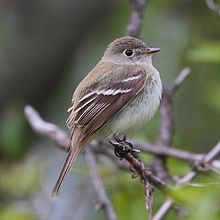
The Least Flycatcher has an unusual behavior among passerines. It forms “aggregations” or “clusters”. In the spring, males establish small territories among a dense cluster of Least Flycatchers, which is reminiscent of a lek mating system.
Least Flycatchers breed in deciduous, and mixed coniferous and deciduous, forests. The largest aggregations of Least Flycatchers that I have observed occur at forest openings. There is a large aggregation outside our house where there are several open acres surrounded by mixed forest, and on the way into Massawepie Mire where there is also a large, circular opening in the forest. Males give their loud “chebec” song all around the forest opening. They have a softer, almost “grumbled”, or also referred to as “guttural”, “speetz” call they give when changing perch locations.
Why do Least Flycatchers form aggregations when most other passerines do not nest in such social groups and establish their own, larger territories? There are several theories, some of which include: female preference for clustered males and pursuit of extra-pair matings, clustering may reduce nest predation, and one that I find intriguing, the open areas near forest aggregations may be neutral feeding grounds used by all the members of the cluster, which reduces conflict and allows for decreased territory sizes.
Least Flycatchers are often described as “pugnacious” and aggressive toward other species. They continuously attack other species when their territories overlap. This aggressive behavior in a cluster of birds may certainly support the theory of reduced nest predation among birds in aggregations.
Further study is needed to fully explain why Least Flycatchers nest in social clusters.
Hi,
So if all you hear is the “chebec” call, how do you distinguish it from the YBFL? On recordings I can hear a slight difference, but to hear it in isolation in the woods, is a whole different matter. I may consider habitat, at lease in certain locations, such as a bit more southern latitude than the ADKs, but that’s not definitive — only providing clues.
I’d be glad to take any tips!
Best Regards
The “chebec” song of the Least Flycatcher is harsher and given more frequently than the Yellow-bellied Flycatcher’s more “liquid” sounding “cha-lick”. Yes, the habitats are different. The Yellow-bellied Flycatcher is found in boreal habitat (mossy ground is always a feature) and the Least Flycatcher is found in deciduous, or mixed deciduous and coniferous, forests. In the Adirondack region, the Yellow-bellied Flycatcher is found in boreal habitat on mountain summits and also in lowland boreal habitat. When I lead trips that transition from deciduous into boreal habitat, I always point out the differences in the song of the Least and Yellow-bellied Flycatchers. They are similar, but you can train your ear to tell the difference!
Joan,
Yesterday I heard and saw a flycatcher at about 3000 feet on the trail up Algonquin (it is awful, but I had a reason for being there). It was mixed forest, getting shorter, but there was no moss on the ground. It was not the least call but not the habitat for nesting for the yellow-bellied. Could it have been a yellow-bellied still moving or unmated, or something? Evelyn